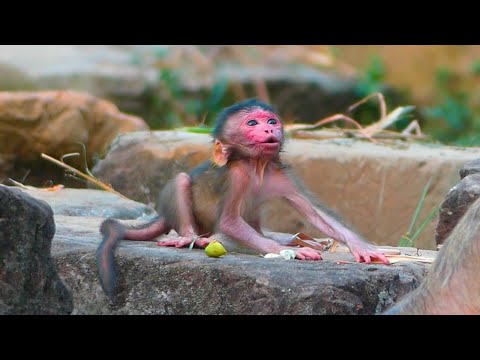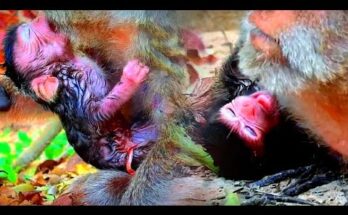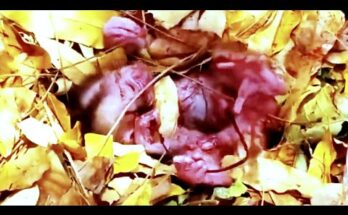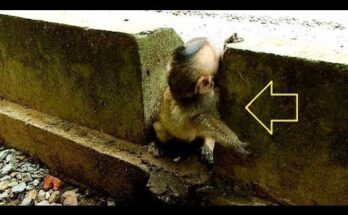
In the heart of a quiet jungle clearing, beneath the soft rustling of leaves and distant calls of birds, a profoundly emotional scene unfolds—one that will move even the hardest of hearts.
A tiny, trembling newborn monkey lies alone on the cold earth. His fur is still wet from birth, his limbs barely coordinated, and his eyes half-opened, flickering with confusion and fear. His body, so small and delicate, seems almost too fragile for this world. With every breath, he lets out soft, sorrowful whimpers—heartbreaking cries that echo through the trees as if pleading for the comfort of someone who isn’t there.
His mother is nearby. But she doesn’t rush to his side.
Instead, she stands awkwardly just a few feet away—nervous, unsure, and deeply conflicted. Her eyes dart between the newborn and the canopy above. Her hands fidget, her feet shift restlessly. It is painfully clear: she is a young, inexperienced mother. Possibly her first birth. And she’s overwhelmed by the sudden weight of motherhood.
She watches as her baby struggles—his cries becoming sharper, his movements more desperate. He lifts his tiny arms, reaching instinctively for warmth, for milk, for a heartbeat to comfort him. But no arms pull him in. No tongue grooms away the afterbirth. No embrace eases his panic.
The mother’s internal conflict is visible. Her instincts tell her to act—to comfort, to nurse, to protect. But fear holds her in place. Maybe she’s frightened by the fragile form before her, unsure if she’s even capable of caring for him. Maybe she’s confused by her own instincts, unfamiliar with what this little creature needs or how to give it.
This is nature at its most vulnerable—not predator versus prey, but love versus fear, instinct versus inexperience.
As the minutes drag on, the tension grows unbearable. The baby’s cries begin to falter, his tiny strength wearing thin. His chest rises and falls rapidly, his mouth opens in silent screams. You can see the desperation behind his eyes, the innocent longing to be held, to be safe.
Finally, something changes.
The mother edges closer. Her body is tense, her eyes wide, but something compels her to move. She crouches beside her baby, sniffing him cautiously, her breath uneven. He lets out a tiny cry, weaker now, but filled with hope. She flinches, then leans in again. Her hands twitch.
Then—the turning point.
She reaches down and gently touches him. Her hand lingers on his back. He responds instantly, nestling closer to her warmth. And in that moment, something ancient and unspoken happens. Her confusion doesn’t vanish, but it fades—just enough. She begins to groom him with awkward, hesitant licks. Not perfect. Not graceful. But real. Tender. Growing.
The cries soften. The baby relaxes.
It’s not a fairytale ending—not yet. The mother still has much to learn. But in that fragile moment, something beautiful is born: the first spark of a bond. A bond built not from instinct alone, but from trial, error, and—above all—love rising out of uncertainty.
🐒 Why This Story Matters
This raw, emotional footage is more than just a touching wildlife moment. It’s a window into the real, often painful challenges animals face when navigating parenthood without guidance or safety. Not all monkey mothers instantly know what to do—just as not all human parents feel prepared. But growth begins with one small act of courage.
This baby monkey cried for connection. And in the end, his mother found the strength to answer.
🎥 Watch the Full Journey
👉 Witness the heartache… the hesitation… and the hope that blooms when a mother decides to try.
💬 Share your thoughts: Have you ever seen a moment of connection so fragile, yet so powerful?
🔁 Share this story to spread awareness of the deep emotional lives of animals and the powerful, universal truth of maternal love.
#BabyMonkey #WildlifeEmotions #MotherhoodInNature #AnimalBonding #HeartbreakingAndHopeful #AnimalBehavior #InnocenceInTheWild #NatureDoesFeel


